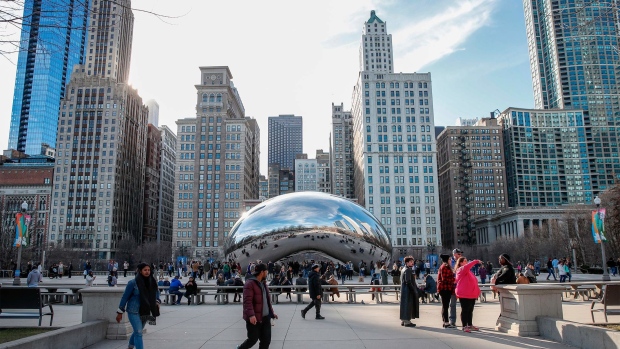Feb 24, 2023
Downtown Chicago Now Has More Residents Than Before the Pandemic
, Bloomberg News

(Bloomberg) -- You wouldn’t know it from the empty streets on a Friday morning, but there are now more people living in downtown Chicago than before the pandemic.
The number of residents in the Loop — as the city’s central business district is known — grew by almost 9% since 2020, according to estimates from the Chicago Loop Alliance.
“The notion that everybody was leaving downtown and leaving cities during the pandemic was somewhat overblown,” said Michael Edwards, president of the Alliance, which represents more than 300 businesses, civic, and cultural institutions.
Population in the Loop, an area bounded by the Chicago River on the north and west sides, stands at 46,000, with the number of residents expected to grow another 17% by 2028, the group estimates. About 95% of residential properties are occupied, up from the pandemic low of 87%, and a rate that exceeds 2019 levels.
The figures are surprising for a central business district that’s faced a slower recovery than many other parts of the country. A University of California study that analyzed cellphone data across 62 cities in North America put Chicago’s recovery at just 50%, behind places including New York City; Washington, DC; Los Angeles; Houston and Boston.
For many residents, Edwards said, shorter commutes continue to make downtown living appealing.
“People are finding that there’s only so much time in your day, and to spend a few hours commuting every day is not a productive use of that time,” he said.
Pandemic Opportunity
Those who moved out of the central business district during the pandemic were mostly families that were already approaching the time they would normally have children and move out anyway, Edwards said. The pandemic just accelerated that trend. But at the same time, rental rates came down, attracting new residents.
“During the pandemic, you could get three, sometimes four months of free rent,” Edwards said. “So some people that had the wherewithal, that maybe were a little bit more tolerant of the pandemic, saw it is a good opportunity.”
The population gain came even as rents shot back up and Chicago battles an increase in violence, with crime complaints in an area that includes the Loop and the South Loop rising 60% last year. The increase in crime is the No. 1 priority for mayoral candidates as Chicagoans hit the polls Tuesday. It’s also sparked concern among some business leaders who say crime has hurt their efforts to recruit and retain employees.
“On any given day in the Loop, people can have a pleasant experience and they’re not going to be impacted by crime,” Edwards said. “Some things that happened since the pandemic and the way people behave, that’s unfortunate. We are doing what we can and we even have invested a million dollars a year in providing safety ambassadors and keeping the streets safe and clean so that people can have a good experience.”
High Earners
The Loop’s population is a fraction of Chicago’s almost 2.7 million people, but its residents tend to earn higher incomes and have higher education levels. That means they contribute more to the economy, spending an estimated $481 million in the district’s businesses in 2022.
That amount could increase significantly if the Loop added more services that residents want, including grocery stores, apparel shops and bookstores, according to the Chicago Loop Alliance’s survey, which interviewed 1,262 people. Loop residents currently spend $940 million a year in other parts of the city.
The cost of housing in the Loop is still too high for many. Households earning less than $75,000 per year find it difficult to pay the district’s rates, and only 1% of the total inventory is made of affordable housing units, according to the report.
Walk to Work
Most of the Loop’s population is 25 to 34 years old, with more than 80% living alone or with one person. Almost half don’t own a car and the majority cite the ability to walk to places, the central location and proximity to work as top reasons for living downtown.
“They’re not afraid of public transit, they want to be close to the lake and they want the conveniences of walking to work,” Edwards said. “They want the nightlife and all of the arts and culture that’s right here.”
The future of the Loop will also be more residential. Another 5,000 housing units are expected to be added by 2028, bringing the district’s total population to 54,000, according to the report. The estimates assume the global economy avoids a major recession, that the cost of building doesn’t become prohibitive and that city incentives to convert commercial blocks into homes move forward. Crime, rising property taxes and developments elsewhere are also threats to the forecast.
--With assistance from Alex Tanzi.
(Updates with affordable housing inventory in 14th paragraph. A previous version of this story was corrected after the Chicago Loop Alliance ameneded population, economic impact figures.)
©2023 Bloomberg L.P.


